Centauri Dreams
Imagining and Planning Interstellar Exploration
New Insights into Titan
It’s hard to consider a place with surface temperatures of -180°C ‘Earthlike,’ but there are reasons why we see the term so often applied to Titan. The most striking of these is the presence of surface lakes and seas, a phenomenon found nowhere else in the Solar System. The temperatures are cold enough to make the circulating fluid liquid methane and ethane rather than water, but we see things in Cassini imagery that are strikingly familiar, including seas fed by river-like channels and large numbers of shallow lakes that appear in flatter areas.
The European Space Agency’s Thomas Cornet has been leading a team investigating Titan’s surface features in greater detail. In particular, the lakes of Titan do not appear to be fed by rivers, making it likely that they are filled either by rainfall or by liquids welling up from below. Empty depressions can be found where lakes may once have been, and it is believed that some of the lakes dry out during Titan’s thirty-year cycle of seasons. Cornet and team wanted to learn how the depressions in which the lakes are found formed in the first place.

Image: A radar image of Titan’s north polar regions (centre), with close ups of numerous lakes (left) and a large sea (right). The sea, Ligeia Mare, measures roughly 420 x 350 km and is the second largest known body of liquid hydrocarbons on Titan. Its shorelines extend for some 2000 km and many rivers can be seen draining into the sea. By contrast, the numerous lakes are typically less than 100 km across and have more rounded shapes with steep sides. The radar images were created using data collected by the international Cassini spacecraft. Credit: NASA/JPL-Caltech/ASI/USGS; left and right: NASA/ESA. Acknowledgement: T. Cornet, ESA.
Here again we find a terrestrial analog for Titan, the ‘karstic’ landforms seen on Earth when rocks like limestone and gypsum erode because of the effects of rainfall and groundwater. Erosion depends on many factors, temperature, rainfall and chemistry among them, but what develops over time are sinkholes and caves in areas where there is abundant moisture, and salt-pans where conditions are more arid. The ESA team studied how long it would take for areas on Titan to go through similar processes, adjusting for the differences in terrain.
Rather than water, Cornet and colleagues assumed liquid hydrocarbons as the primary dissolving agent, while modeling a surface replete with solid organic material. Given what we know about Titan’s climate, the result was a period of 50 million years to create a 100-meter deep depression at Titan’s rainy high polar latitudes, where we see so many lakes. The team believes this time scale is compatible with what appears to be a relatively youthful surface.
Cornet describes the work and its results:
“We compared the erosion rates of organics in liquid hydrocarbons on Titan with those of carbonate and evaporite minerals in liquid water on Earth. We found that the dissolution process occurs on Titan some 30 times slower than on Earth due to the longer length of Titan’s year and the fact it only rains during Titan summer. Nevertheless, we believe that dissolution is a major cause of landscape evolution on Titan, and could be the origin of its lakes.”

Image: Close-up radar image showing both empty and liquid-filled depressions (coloured blue) on Saturn’s largest moon, Titan. Credit: NASA/ESA. Acknowledgement: T. Cornet, ESA.
Those arid regions at lower latitudes, as you might expect, take much longer to develop the same kind of depressions, up to 375 million years according to the team’s modeling. Here again the time scale is consistent with the observed scarcity of depressions in these regions of the moon. Thus the comparison with Earth remains surprisingly useful, although the processes at work continue under entirely different climate and chemical conditions.
A Polar Wind Like Earth’s
An atmospheric phenomenon on Titan is likewise replicated in its own way on our own world. Seven years of data from the Cassini probe have helped a team at University College London reach conclusions about the so-called ‘polar wind’ on Titan that is driving gas from its atmosphere. Data from the Cassini Plasma Spectrometer (CAPS) show that about seven tons of hydrocarbons and nitriles are being lost into space every day.
The question the study answers is why this is happening. Titan’s atmosphere is primarily nitrogen and methane. Nitriles are molecules with tight nitrogen/carbon bonds. Andrew Coats (UCL), who led the investigation of the polar wind, explains their interactions:
“Although Titan is ten times further from the Sun than Earth is, its upper atmosphere is still bathed in light. When the light hits molecules in Titan’s ionosphere, it ejects negatively charged electrons out of the hydrocarbon and nitrile molecules, leaving a positively charged particle behind. These electrons, known as photoelectrons, have a very specific energy of 24.1 electron volts, which means they can be traced by the CAPS instrument, and easily distinguished from other electrons, as they propagate through the surrounding magnetic field.”
A major difference between Titan and Earth is that the former has no magnetic field. It is, however, surrounded by Saturn’s rotating magnetic field, which forms a comet-like tail around the moon. The CAPS instrument, in 23 flybys in which Cassini moved through Titan’s ionosphere or its magnetic tail, detected photoelectrons up to 6.8 Titan radii out, showing how efficiently they move along magnetic field lines. What Coates and team have done is to show how the negatively charged photoelectrons create an electrical field that continues to pull hydrocarbon and nitrile particles out of the atmosphere wherever it is lit by the Sun.
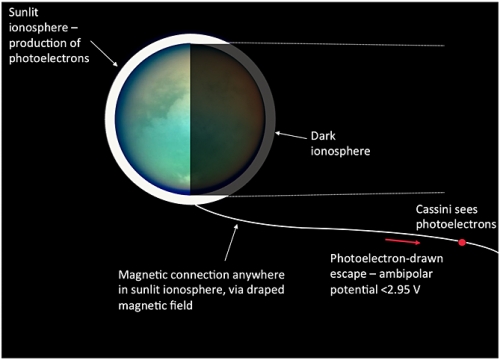
Image: Schematic illustration of the magnetic connection between the sunlit ionosphere (left) and Cassini in the tail. Credit: UCL/Andrew Coates.
The same phenomenon occurs on Earth but only in the polar regions, where the magnetic field is open. Titan is not similarly constrained, which is why we see much more widespread effects. As the paper notes: “…we have presented new observations of the photoelectron spectra in Titan’s sunlit ionosphere and in the tail. The results again confirm a magnetic connection between the sunlit ionosphere and tail, along the draped magnetic field lines.”
In both cases, we generate a polar wind, and similar processes may exist on Mars and Venus, making Titan, if not ‘Earthlike,’ a world with intriguing similarities to terrestrial-class planets.
The Coates paper is “A New Upper Limit to the Field-Aligned Potential Near Titan,” published in Geophysical Research Letters 18 June 2015 (abstract). The Cornet paper on Titan’s surface is “Dissolution on Titan and on Earth: Towards the age of Titan’s karstic landscapes,” accepted for publication in Journal of Geophysical Research – Planets.

Kepler-138b: A Mars-Size Exoplanet
Astronomers at Penn State, NASA Ames, the University of Chicago and the SETI Institute are publishing news of an exoplanetary first: A planet smaller than Earth whose mass and size have both been measured. Kepler-138b is a Mars-sized world orbiting a red dwarf about 200 light years from Sol in the constellation Lyra. This is transit work, focusing on a system with two other transiting worlds, all three of which are too close to their parent star to make life a likely possibility.
If we look back at how far exoplanet research has come in the last fifteen years, it’s startling to realize that Kepler-138b, with a mass of about 6.7 percent that of the Earth, is 3000 times less massive than the first planet whose density was measured. That’s the word from Eric Ford (Penn State), a co-author on the study, which is being published today in Nature, and I assume he’s talking about HD 209458 b, whose size and density were first measured in 1999.
Previous work on the Kepler-138 system had measured the masses of the two outer planets, but the new work used additional Kepler data that not only allowed measurement of the small inner planet but tightened up mass measurements of the outer planets as well. Daniel Jontof-Hutter, a colleague of Ford’s at Penn State who led the study, comments on the methods used:
“Each time a planet transits the star, it blocks a small fraction of the star’s light, allowing us to measure the size of the planet. We also measured the gravity of all three planets, using data from NASA’s Kepler mission, by precisely observing the times of each transit. Each planet periodically slows down and accelerates ever so slightly from the gravity of its neighboring planets. This slight change in time between transits allowed us to measure the masses of the planets.”
Out of knowledge of both mass and size, exoplanet researchers can calculate the planet’s density. A low density planet is assumed to be primarily made of hydrogen and helium, while planets whose density is intermediate are thought to contain a high proportion of water. High density worlds are likely to have the same rocky composition as the Earth itself.
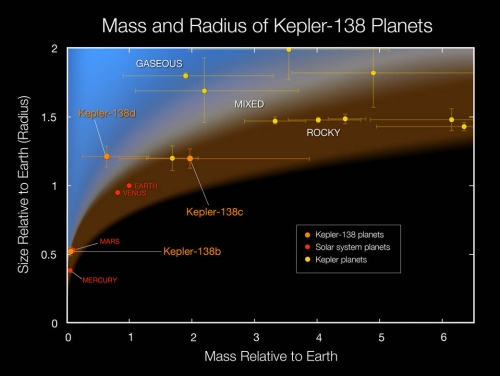
Image: This plot shows the masses and sizes of the smallest exoplanets for which both quantities have been measured. The solar system planets (shown in red) are for comparison. The three Kepler-138 planets (shown in orange) are among the four smallest exoplanets with both size and mass measurements. Kepler-138b is the first exoplanet smaller than Earth to have both its mass and size measured. This significantly extends the range of planets with measured densities. Credit: NASA Ames/W Stenzel.
Given its mass and size, Kepler-138b is probably a rocky world, but further observations will be needed to confirm this. The two outer planets in this system, Kepler-138c and Kepler-138d, are both approximately the size of the Earth, as this NASA Ames news release notes. The researchers believe Kepler-138c, whose density is similar to Earth, is rocky, while Kepler-138d, although roughly the same size, is less than half as dense, implying the presence of a greater proportion of low-density constituents like water and hydrogen.
“The substantial difference between the densities of the two larger planets tells us that not all planets similar to Earth in size are rocky,” said Jack Lissauer, co-author and planetary scientist at NASA’s Ames Research Center in Moffett Field, Calif. “Further study of small planets will help provide more understanding of the diversity that exists in nature, and will help determine if rocky planets like Earth are common or rare.”
Image: This animation shows the mass-radius diagram based on measurements of 127 exoplanets. The video begins by showing planets with masses similar to Jupiter and slowly zooms towards small masses and radii planets to display a comparison of the physical properties of the Kepler-138 planets relative to Earth, Venus, Mars and Mercury. The planet Kepler-138b is the first exoplanet smaller than the Earth to have both its mass and its size measured, and is one of three planets that orbit the star Kepler-138, and pass in front of it, or transit, every orbit. Each time a planet transits the star, it blocks a small fraction of the star’s light, allowing astronomers to measure the size of the planet. All three planets were identified by NASA’s Kepler mission that has discovered over a thousand planets around other stars. Credits: Jason Rowe, NASA Ames/SETI Institute.
The paper is Jontof-Hutter et al., “The mass of the Mars-sized exoplanet Kepler-138 b from transit timing,” Nature 522 (18 June 2015), 321-323 (abstract).

Interplanetary Updates: Philae and New Horizons
Given that the Philae lander has just come to life after seven months without communicating, it’s no wonder that the mood among everyone involved with Rosetta’s mission to comet 67P/Churyumov-Gerasimenko is exuberant. On the surface of the comet, conditions have been improving for Philae since March, meaning that with higher temperatures and better illumination, it was hoped that the lander might reactivate. That hope was realized on June 13 when Rosetta picked up 330 data packets from an earlier segment of the lander’s mission.
Stephan Ulamec (DLR), Philae lander project manager, has positive things to say:
“We are still examining the housekeeping information at the Lander Control Centre in the DLR German Aerospace Center’s establishment in Cologne, but we can already tell that all lander subsystems are working nominally, with no apparent degradation after more than half a year hiding out on the comet’s frozen surface.”
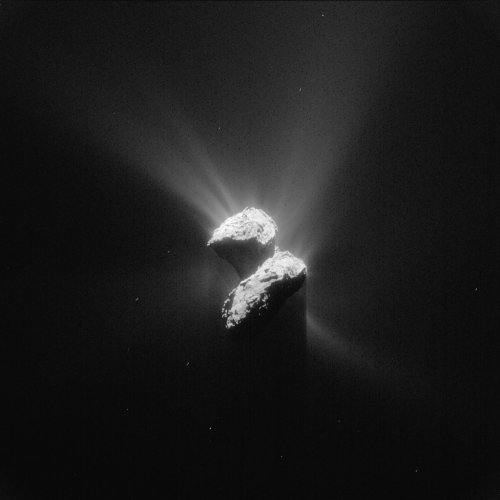
Image: Processed NAVCAM image of Comet 67P/C-G taken on 5 June 2015. Credit: ESA/Rosetta/NAVCAM – CC BY-SA IGO 3.0.
ESA also reports that a second burst of lander data was received on June 14. Apparently over 8000 packets of additional status data are available in Philae’s memory, but controllers are not clear as to when the data were recorded. We do know that the internal temperature of the lander has risen to -5ºC, an indication that we’re moving toward enough sunlight to reach the operating temperatures needed for normal operations and electricity generation.
67P/Churyumov-Gerasimenko rotates about every twelve hours. Philae needs at least 19 watts to switch on its transmitter, and ESA’s Rosetta blog reports that power levels are at about the 13 W level at comet sunrise and reach 24 W later in the cometary day. We’re learning that the lander’s solar panels are apparently generating power for over 135 minutes in each period of illumination. The downloaded telemetry evidently extends over a full day-night cycle of the comet, which makes it possible to infer how and when the lander is receiving sunlight.
Remember that communications are being relayed through the Rosetta orbiter, which can contact the lander twice every 24 hours. Because Rosetta is currently in a 200 to 235 kilometer orbit that is not optimized for communications with the lander, a trajectory change will be needed. The new orbit, scheduled to begin at 2325 UTC today, would reduce the orbiter’s distance to about 180 kilometers and should enable better contact with Philae. Establishing reliable contact and optimizing it will allow a new phase of science investigations to begin.
New Horizons: Trajectory Tune-Up
We’re now inside the one month mark before arrival at Pluto/Charon, and the plucky New Horizons couldn’t have been sent on a more interesting trajectory. The plan is to take the spacecraft inside the orbits of all five of Pluto’s moons, an approach known to be feasible following multiple sets of observations dedicated to spotting potential hazards. New Horizons’ Long-Range Reconnaissance Imager (LORRI) camera performed the work, returning the long exposure images needed to search for rings, even smaller moons and dust in the system.
The upshot: No new moons and no rings. This update from the New Horizons team notes that if any rings do exist, they would have to be less than 1600 kilometers wide or reflecting less than one five-millionth of the incoming sunlight. Another hazard search begins June 15 — this is an ongoing process — and we’ll get the update on those results by June 25. The final far encounter phase — Approach Phase 3 — begins in the last week of June and ends a week before the spacecraft’s close approach to Pluto. Additional images for final navigation uses are part of this phase, as are measurements of the solar wind and high-energy particles on the approach.

Image: This “movie,” composed of images taken by New Horizons’ Long Range Reconnaissance Imager (LORRI), shows Pluto as it rotates about its axis. The images were taken May 28-June 3, 2015, from distances ranging from approximately 56 million kilometers to 48.5 million kilometers. Visible are dramatic variations in Pluto’s surface features as it rotates. When a very large, dark region near Pluto’s equator appears near the limb, it gives Pluto a distinctly, but false, non-spherical appearance. Pluto is known to be almost perfectly spherical from previous data. Credit: NASA/Johns Hopkins University Applied Physics Laboratory/Southwest Research Institute.
New Horizons performed a 45-second thruster burn to optimize its trajectory on June 14, a change of a mere 52 centimeters per second based on previous imaging. It’s mind-boggling for those of us who grew up with Pluto as little more than a seemingly unreachable speck at system’s edge to realize that New Horizons is now less than 35 million kilometers out. We’re headed for a close approach at a distance of roughly 12,500 kilometers above the surface.
The second installment of “New Horizons: Countdown to Pluto” airs today at 1130 EDT (1530 UTC) on NASA TV, with repeat showtimes at 1530 EDT (1930 UTC) and 1930 EDT (2330 UTC). In this installment, mission team members Alice Bowman, Cathy Olkin and Chris Hersman will be going through the latest news on mission operations and science.

A Cometary Reawakening
In a summer already packed with interesting missions, we also have the unusual phenomenon of spacecraft ‘waking up’ after unexpected periods of dormancy. The European Space Agency’s Philae lander, which shut down on November 15, 2014 after operating on comet 67P/Churyumov-Gerasimenko for about sixty hours, came out of its hibernation on June 13. ESA reports more than 300 data packets have been received and are being analyzed.
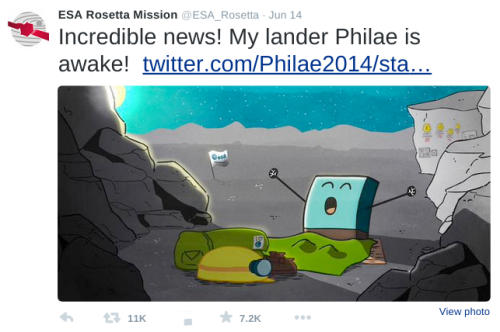
Image: Twitter lit up with news of Philae’s reappearance. Be sure to track @ESA_Rosetta to keep up with the latest.
This first contact since November lasted for 85 seconds, and according to reports from ESA, made it apparent that the lander had been retrieving data during the time of communications blackout. This ESA update notes that there are more than 8000 data packets in Philae’s memory that can be accessed (we hope) on the next contact, giving us information about the lander’s most recent activity as the comet and orbiting Rosetta continue toward perihelion.
DLR Philae project manager Stephan Ulamec adds this heartening note: “Philae is doing very well: It has an operating temperature of -35ºC and has 24 Watts available. The lander is ready for operations.” The lander and orbiting Rosetta have been at the comet for 313 days now, and just as with New Horizons, we have a countdown clock, this time showing 58 days to perihelion (New Horizons’ clock stands at 28 days, 23 hours, 57 minutes when last checked).

Image: The last moments of Philae’s descent, the imprint of its touchdown, and subsequent drift away from the Agilkia landing site was captured by Rosetta’s OSIRIS camera. All times in UT onboard spacecraft time. Credit: ESA/Rosetta/MPS for OSIRIS Team MPS/UPD/LAM/IAA/SSO/INTA/UPM/DASP/IDA.
Philae’s problems began when its harpoons did not deploy and the ice screws meant to secure it to the cometary surface proved ineffective on their own. The craft rebounded rather than landing at the Agilkia landing site and took two hours to come to rest at a site called Abydos. Along the way, the lander evidently struck a surface feature and tumbled, traveling more than a kilometer from its initial contact point. The rough terrain it wound up in is near a cliff and mostly in shadow.
Philae’s safe mode was triggered by lack of access to sunlight and apparent problems with the spacecraft’s orientation at the landing site. The theory had been that additional sunlight striking the solar panels by later this summer might reboot the lander. If we can continue to make contact with the craft, it will be an instance of rugged components surviving extreme temperatures (down to ?160 °C). The lander’s battery is designed to recharge only when internal temperatures are above 0 °C, so we’ll just have to see what happens next.
What an opportunity Philae represents, riding on a comet as it heats during its approach toward the Sun, and of course the Rosetta orbiter remains healthy with its own view of cometary events. Meanwhile, this tweet from The Planetary Society’s Jason Davis announced the inevitable for a second mission that had experienced an ‘awakening’ during its flight. Atmospheric drag had, as expected, caught up with LightSail on Sunday.

As to that reawakening, LightSail suffered from software problems and needed a reboot of its own to get back into communication with ground controllers. Even after the event, communication problems continued, and the upcoming 2016 LightSail mission will also need to address the issues with attitude control that the first LightSail experienced. Nonetheless, this first go at a CubeSat solar sail succeeded at sail deployment and produced data that should make its successor a stronger craft. Here’s a June 8 view of LightSail from the Netherlands, a tough little spacecraft that got its job done despite huge problems along the way.


Pluto: Surface Features Emerging
New imagery from New Horizons continues to dazzle, with the images below taken by the spacecraft’s Long Range Reconnaissance Imager (LORRI) instrument from May 29 to June 2. We’re beginning to pick up bright areas mixed with dark terrain in what are clearly the best images ever obtained of the remote world. As before, mission scientists are using deconvolution to sharpen the raw images and are also teasing out further details with contrast adjustments. The processing can produce artifacts so that fine details will have to be checked at closer range.

Image: These images, taken by New Horizons’ Long Range Reconnaissance Imager (LORRI), show four different “faces” of Pluto as it rotates about its axis with a period of 6.4 days. All the images have been rotated to align Pluto’s rotational axis with the vertical direction (up-down) on the figure, as depicted schematically in the upper left. From left to right, the images were taken when Pluto’s central longitude was 17, 63, 130, and 243 degrees, respectively. The date of each image, the distance of the New Horizons spacecraft from Pluto, and the number of days until Pluto closest approach are all indicated in the figure. Credit: NASA/Johns Hopkins University Applied Physics Laboratory/Southwest Research Institute.
We’re still 39 million kilometers from Pluto but the action is getting very interesting indeed. Here’s New Horizons principal investigator Alan Stern (SwRI, Boulder) on what we see in the new views:
“Even though the latest images were made from more than 30 million miles away, they show an increasingly complex surface with clear evidence of discrete equatorial bright and dark regions—some that may also have variations in brightness. We can also see that every face of Pluto is different and that Pluto’s northern hemisphere displays substantial dark terrains, though both Pluto’s darkest and its brightest known terrain units are just south of, or on, its equator. Why this is so is an emerging puzzle.”
Describing ‘an increasingly complex and nuanced surface,’ Stern points out that by early July we will have spectroscopic data to help work out just what these differences in terrain are. I also want to add that the discussion of New Horizons’ latest imagery on the Unmanned Spaceflight site has been extremely helpful — just drill down to the New Horizons mission. Unmanned Spaceflight has long been a key resource for those tracking missions throughout the system.
Meanwhile, the pace of news is obviously accelerating. NASA is planning weekly updates on the New Horizons mission for June 16, 23 and 30, but when we get into July, things really heat up, with daily updates live on NASA TV starting on July 7 as we move toward final approach.
With excitement building, be aware of ‘The Year of Pluto,’ a new documentary on Pluto and the New Horizons mission that places the spacecraft in context. New Horizons can be said to be closing out our first scouting phase of the classical planets and beginning the exploration of the Kuiper Belt. NASA TV will have ‘The Year of Pluto’ available beginning Friday June 12th on the following schedule (all times EDT): Friday, June 12 @ 1000, 1300, 2000; Saturday, June 13 @ 0600, 1600, 2100; Sunday, June 14 @ 0800, 1300, 2000. Here’s the trailer for a preview.
As we approach July, it’s also heartening to see the rising degree of public interest in New Horizons. I’ve mentioned Pluto Safari, a free app that uses 3D simulations to follow the mission on both iOS and Android devices (available here for iOS and here for Android). Simulation Curriculum, creators of Starry Night, is behind Pluto Safari, and given its interactive mission information, the app is a real bonus for those following the mission as closely as I do.
From the New Horizons team itself comes Pluto Time, an online tool that tells you, once you’ve entered your location, when your site is experiencing about the same degree of illumination as Pluto itself. Walk outside at the designated time and, given variables of weather and terrain, your surroundings will be roughly as bright as Pluto at noon. NASA is encouraging people to take photos during their local Pluto time and share them with social media using the tag #PlutoTime. Pluto Time surprises me a bit in that my next time will be just past 2030, deep into the evening, to be sure, but a good bit brighter than I had imagined Pluto even at noon.

Image: An artist’s impression of Pluto’s surface. The Sun appears about 1,000 times fainter than it does on Earth. The moon Charon looms large in the sky. Image Credit: NASA / Southwest Research Institute / Alex Parker.

Ceres Up Close (and a Bit of Bradbury)
I know I’m going to remember the summer of 2015 for a long time. The confluence of deep space missions has brought new images every week, including the latest view of Ceres and its enigmatic bright spots, which appears below. I’m already bracing myself for that Voyager-like sense of deflation once New Horizons gets past Pluto/Charon and the long-anticipated targets dwindle. Pluto has a special place for some of us because we grew up with it being considered the ninth planet. Dwarf planet or not, it’s the final act of a classic Solar System tour.
Not that we won’t be returning to many of these places, but the timing is uncertain and once Juno finishes its work at Jupiter, we’ll have no missions on their way to the outer planets. That makes this summer both energizing and a bit poignant, but let’s enjoy it while we can. This view of Ceres, taken on June 6, really is spectacular. We’re seeing the dwarf planet from 4400 kilometers as Dawn flies its second mapping orbit. The resolution is 410 meters per pixel.
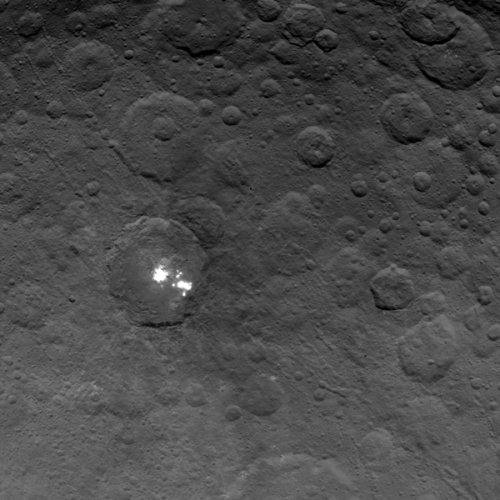
It’s the bright spots that continue to seize the imagination, as Chris Russell (UCLA), principal investigator for the Dawn mission, notes:
“The bright spots in this configuration make Ceres unique from anything we’ve seen before in the solar system. The science team is working to understand their source. Reflection from ice is the leading candidate in my mind, but the team continues to consider alternate possibilities, such as salt. With closer views from the new orbit and multiple view angles, we soon will be better able to determine the nature of this enigmatic phenomenon.”
The crater enclosing the brightest of the spots is about 90 kilometers across, and so far we have no clear explanation for where they appear or why they are as bright as they are. Like Vesta, Ceres reveals abundant cratering, but as this JPL news release makes clear, the latter shows a good deal more activity on the surface in the form of landslides and other flows. April’s color map, discussed at the 2015 General Assembly of the European Geosciences Union in Vienna, shows differences in color and terrain suggesting that Ceres was once an active body.

Image: This map-projected view of Ceres was created from images taken by NASA’s Dawn spacecraft during its initial approach to the dwarf planet, prior to being captured into orbit in March 2015. Credit: NASA/JPL-Caltech/UCLA/MPS/DLR/IDA.
The plan is for Dawn to continue in its 4400-kilometer orbit until June 28 before moving to 1450 kilometers, an altitude it will descend to in early August. The views, in other words, should continue to improve. Are we looking at an object that will one day become important to a system-wide infrastructure? John S. Lewis has suggested that Ceres could be a primary base for transport and operations in the asteroid belt, as well as a valuable stepping stone for the exploration of objects still further out, such as the icy moons of Jupiter and Saturn.
Working with Ken Roy and David Fields, Robert Kennedy has examined Ceres as a ‘shell world,’ one that could be ultimately transformed by being enclosed in a spherical shell of matter that could house an atmosphere and ecosystem. We’ve bandied the idea around extensively in the comments here ever since it was presented at the 2011 Tennessee Valley Interstellar Workshop session in Oak Ridge (see Terraforming: Enter the ‘Shell World’). The problems are formidable, but the authors note in a JBIS paper that a terraformed Ceres that is half ocean yields enough dry land to approximate the area of Indonesia, on a world with a gravity well only 1.5 percent that of Earth. Think of it as an enclosed micro-gravity tropic zone.
All of which, combined with this summer of deep space achievement, brings Ray Bradbury’s short story ‘Rocket Summer’ irresistibly to mind:
Rocket summer. People leaned from their dripping porches and watched the reddening sky.
The rocket lay on the launching field, blowing out pink clouds of fire and oven heat. The rocket stood in the cold winter morning, making summer with every breath of its mighty exhausts. The rocket made climates, and summer lay for a brief moment upon the land…
Such distant futures are fascinating in their own right and I applaud their exploration, but right now we’re in the midst of first-wave exploration by machine, and it’s clear that Ceres has many secrets yet to divulge, including the question of whether or not it has an internal ocean. Much rides on the outcome, but Ceres as refueling stop for Brian McConnell and Alex Tolley’s ‘spacecoach’ is an attractive proposition as we develop human missions to the outer planets.
The paper on terraforming Ceres is Roy, Kennedy and Fields, “Shell Worlds: An Approach to Terraforming Moons, Small Planets and Plutoids,” JBIS Vol. 62 (2009), pp. 32-38. John Lewis’ new book is Asteroid Mining 101: Wealth for the New Space Economy (WaveCloud Corporation, 2014).


